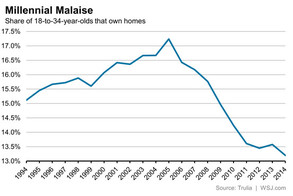
New data show that household formation slowed considerably last year, a potentially ominous sign for the housing market.
Household formation is a key driver of demand for housing. When the economy stumbles and joblessness rises, more people tend to move in with family or double up with roommates. When the economy expands, the opposite takes place as people strike out on their own. Household formation also rises when immigration increases.
Last week, an annual Census Bureau survey showed that the U.S. added just 476,000 households in the year ended in March, compared with an average of 1.3 million in each of the prior two years.
The Census releases a separate quarterly survey that also provides household formation figures, though economists say the annual survey is a better gauge of household formation. The quarterly survey has also shown weak household formation, around 650,000 new household, for the same period measured by the annual survey that runs from March to March.
Household formation is a key driver of demand for housing. When the economy stumbles and joblessness rises, more people tend to move in with family or double up with roommates. When the economy expands, the opposite takes place as people strike out on their own. Household formation also rises when immigration increases.
Last week, an annual Census Bureau survey showed that the U.S. added just 476,000 households in the year ended in March, compared with an average of 1.3 million in each of the prior two years.
The Census releases a separate quarterly survey that also provides household formation figures, though economists say the annual survey is a better gauge of household formation. The quarterly survey has also shown weak household formation, around 650,000 new household, for the same period measured by the annual survey that runs from March to March.

 RSS Feed
RSS Feed